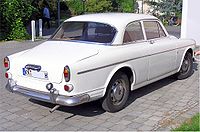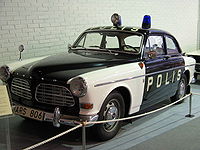Volvo Amazon
| Volvo | |
|---|---|
|
Volvo 121 (1964)
|
|
| Amazon (series 120/130/220) |
|
| Production period: | 1956-1970 |
| Class : | Middle class |
| Body versions : | Limousine , station wagon |
| Engines: |
Petrol engines : 1.6–2.0 liters (44–87 kW) |
| Length: | 4440-4460 mm |
| Width: | 1620 mm |
| Height: | 1505-1530 mm |
| Wheelbase : | 2600 mm |
| Empty weight : | 1070-1200 kg |
| Previous model | Volvo PV444 / PV445 |
| successor | Volvo 140 |
The Volvo Amazon was a mid-range car from the Swedish car manufacturer Volvo . Outside of Scandinavia , the model was mostly marketed as the 120/130 series .
667,323 cars were produced between October 1961 and July 1970. Outside of Sweden, the model was referred to as the 120 series because the name “Amazon” was already protected for the German two-wheeler manufacturer Kreidler, which was simultaneously selling the “Kreidler Amazone” moped in many sales markets . Later, however, the name Amazon for the Volvo model spread beyond Scandinavia. In the first year of production it was officially called "Amason", which was later changed to the "more cosmopolitan" Amazon.
With this model, Volvo laid the foundation for its later success as an automobile manufacturer and established its reputation as a manufacturer of particularly safe automobiles. From the end of the 1950s, crash tests were carried out and, as a result, the two models PV 544 and P 121 Amazon were the first automobiles worldwide to have three-point seat belts on the front seats as standard .
meaning
The Amazon was the first four-door Volvo with a self-supporting body and, after the PV 444 presented in 1944, the second large-scale production car from Gothenburg . With an export share of more than 60%, the car not only opened up the most important European markets for Volvo, but was also successful in the USA. For the US market and for Germany, Austria and Switzerland, the most powerful 123 GT model with 103 PS (measured according to DIN; 76 kW) was presented in 1966. Before that, there was a small number of the 122 SR, a version with 128 PS (94 kW).
development
The Amazon was presented in the fall of 1956. It had the water-cooled front engine and the chassis of the PV 544 with the same wheelbase and individually suspended front wheels on double wishbones of unequal length , Gemmer steering , a driven rigid rear axle on four trailing arms and a Panhard rod as well as coil springs and telescopic shock absorbers on all wheels. The then modern pontoon shape of the body was designed in Volvo's new design department by the Swede Jan Wilsgaard , who was based on the Italian Alfa Romeo 1900 . The strongly curved rear window, together with the graceful roof posts, enabled a good all-round view. The station wagon, built from 1962, had a split tailgate, the lower half of which was folded back, which made loading easier.
In March 1958, the Amazon S (P 122 S) with a two-carburetor engine and 83 hp (61 kW) was also presented. In August 1961, the displacement was increased from 1.6 liters (B 16 engine) to 1.8 liters and the previously triple-bearing crankshaft was given five bearings. At the same time there was a 12-volt system and front disc brakes for the Amazon S, which were only used later on the weaker type. From August 1963, the car was available with an automatic transmission from Borg-Warner , with a dual-circuit brake and split steering column from August 1967.
The four-door sedan was produced until July 1967. The two-door version introduced in October 1961 was the last model to be discontinued in July 1970 in Torslanda , Sweden . The five-door station wagon (P 221) was in production from February 1962 to May 1969.
In order to avoid the EEC import duty , the car was assembled from 1965 at the Volvo plant in Ghent (Belgium) from sets of parts that were delivered from Sweden.
From 1968 the engine had a displacement of 2 liters (engine B 20).
Facelift
Despite the long construction time, the years of construction of the Volvo Amazon differ only slightly from the outside. The vehicles show the most striking differences in the two-part radiator grille and the handle of the case lid.
The first vehicles had a wide chrome rim around the two openings in the radiator grille with a wide central bar that was also chrome-plated. Behind it was a grill made of evenly shaped small rectangles. The lid of the case had a two-part handle. From 1958, the Volvo Amazon was the first mass-produced vehicle to have seat belts as standard . At the same time, the trunk lid handle was changed. It was now one-piece with an integrated Volvo badge.
From 1962, the wide chrome rim at the openings in the radiator grille became significantly narrower, only a wider center bar remained. The grill itself now had 9 vertical and 12 horizontal struts.
In 1964 (model year 1965) the case lid handle was modified again. It was now much narrower and only had a Volvo logo in the middle. The radiator grille only had three vertical and ten horizontal struts per opening. The rims were no longer painted in the same color as the car, but in a uniform matt silver with cooling holes for the front disc brakes, which are now standard, and the large “V” with a red background on the hubcaps has been replaced by a small one with a black background.
In 1967, next to each of the three vertical struts per opening, another parallel was added in the radiator grille at a short distance. In the summer of the same year, the Amazon got a new four-spoke steering wheel. Instead of the large signal ring that "tapered" towards the top in an inverted V, there were now two chrome-plated horn buttons. This steering wheel was also available for the Volvo 142/144/164 from 1971.
From 1969 the equipment of the Amazon became simpler and less attractive in favor of the new Volvo 140 and Volvo 164 models. The trim strips on the rain gutter and on the bonnet were no longer necessary. The rear vent windows had simpler handles and the front bumper horns were saved. The interior was also meager: the door pockets were missing, the handbrake lost its safety eyelet and reclining seat fittings were no longer available.
Types
Model names:
- 121 : four-door notchback sedan with single-carburetor engine, from October 1956
- 122 S : four-door notchback sedan with two-carburetor engine, from 1958
- 123 GT : two-door notchback sedan with B18B / B20 (two-carburetor) engine, from 1967
- 131 : two-door notchback sedan with single-carburetor engine, from October 1961
- 221 : five-door station wagon with single-carburetor engine, from February 1962
Bodies:
- P120: four-door notchback sedan, built from October 1956 to July 1967; Number of items: 234,200
- P130: two-door notchback sedan, built from October 1961 to July 1970; Number of units: 359,900
- P220: five-door station wagon, built from February 1962 to May 1969; Number of items: 73,200
Engines:
- B16A with 1580 cm³ and 44 kW (60 PS); October 1956 to July 1961; Model 121
- B16B with 1580 cm³ and 56 kW (76 PS); October 1956 to July 1961; Model 122 S
- B18A with 1780 cm³ and 50 kW (68 PS); from 8/66 75 hp; August 1961 to July 1968: models 121, 131, 221
- B18D with 1780 cm³ and 59 kW (80 PS); from 8/65 86 hp; from 8/66 90 hp; August 1961 to July 1968: Model 122 S
- B18B with 1780 cm³ and 71 kW (96 PS); August 1967 to July 1968: Model 123 GT
- B20A with 1990 cm³ and 60 kW (82 PS); August 1968 to July 1970: models 121, 131, 221
- B20B with 1990 cm³ and 76 kW (103 PS); August 1968 to July 1970: Models 122 S, 123 GT
Transmission:
- H6: three-speed manual (until January 1958)
- M4: four-speed manual (until July 1961)
- M30: three-speed manual
- M31: three-speed manual with overdrive
- M40: four-speed manual
- M41: four-speed manual with overdrive
- BW35: three-speed automatic (from August 1963 as special equipment)
Foreign production
Motor Assemblies in South Africa assembled almost 14,000 copies of this model from 1961. In Divolvo in Chile also nearly 3,000 units were built 1962-1970. The model was assembled by Volvo Canada in Dartmouth (Nova Scotia) , a suburb of Halifax , under the name Canadian .
swell
- Oldtimer Markt special issue 21 (1998), VF Verlagsgesellschaft mbH, Mainz
- Oldtimer Markt 11/2006, VF Verlagsgesellschaft mbH, Mainz p. 147 ff.
Web links
Individual evidence
- ↑ lexicar.de
- ↑ Hans W. Mayer: From leather straps to high-tech lifesavers. In: FAZ.net . March 4, 2009, accessed December 14, 2014 .
- ^ M. Compton / TJ Gallwey: Motor Assemblies Limited. A small South African Assembly Plant that became a major manufacturer , 2009.
- ^ Karl Eric Målberg / Fredrik Lofter: Production of Volvo Amazon on Volvo Amazon Picture Gallery .
- ↑ Brendan Mc Aleer: What is the most Canadian car ever? In: North Shore News. July 17, 2017, accessed May 5, 2018 .
- ↑ Dimitry Anastakis: Building a "New Nova Scotia": State Intervention, The Auto Industry and the Case of Volvo in Halifax, 1963-1998 , in: Acadiensis Volume 34 (2004), pp. 3-30.








